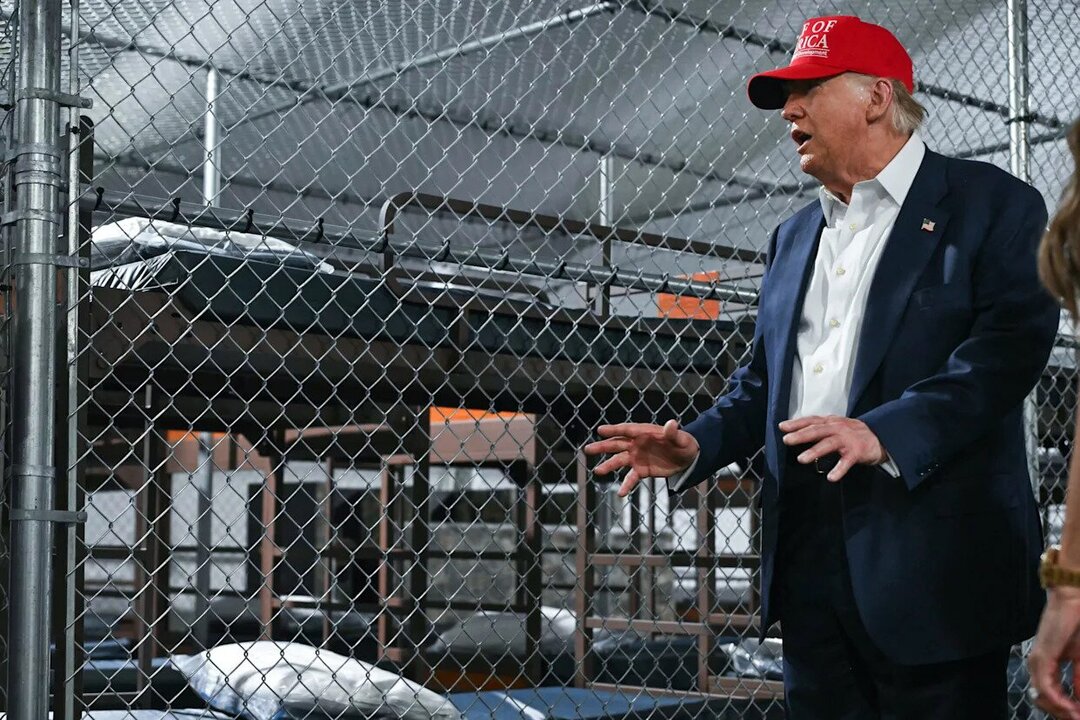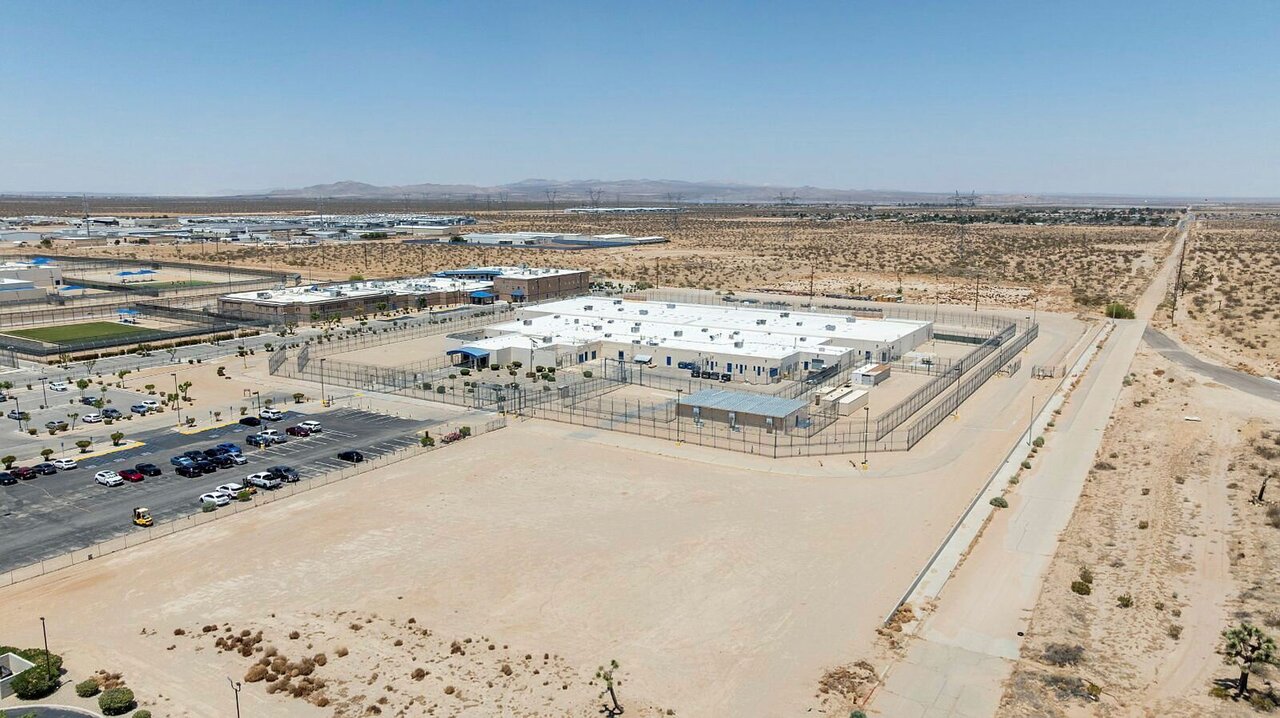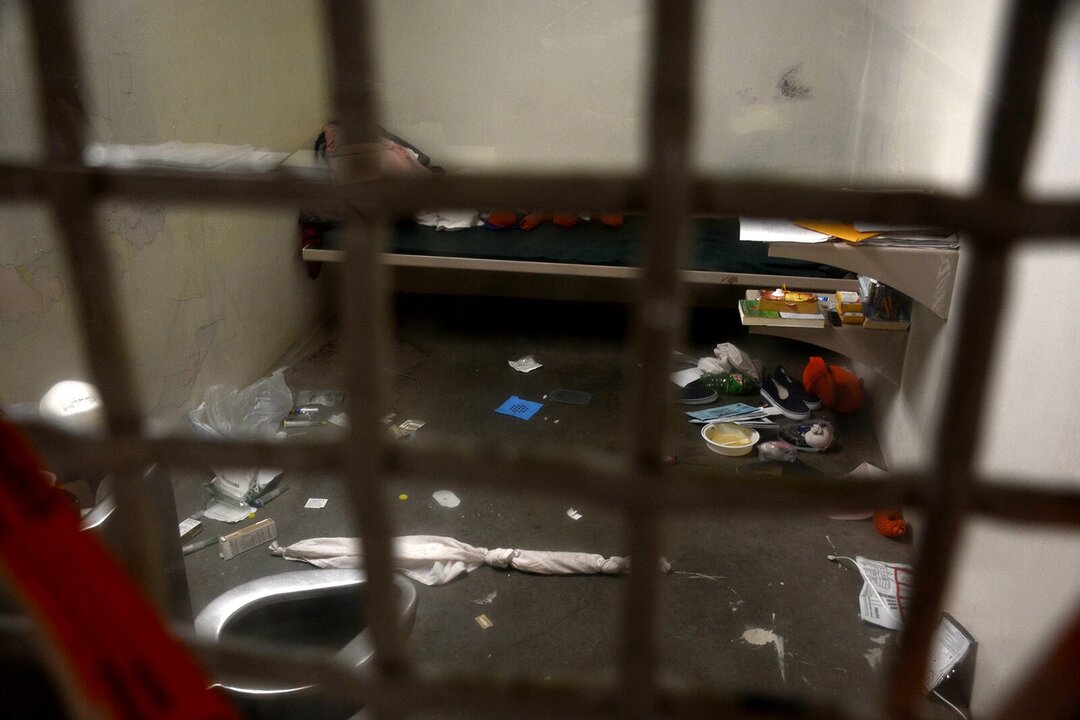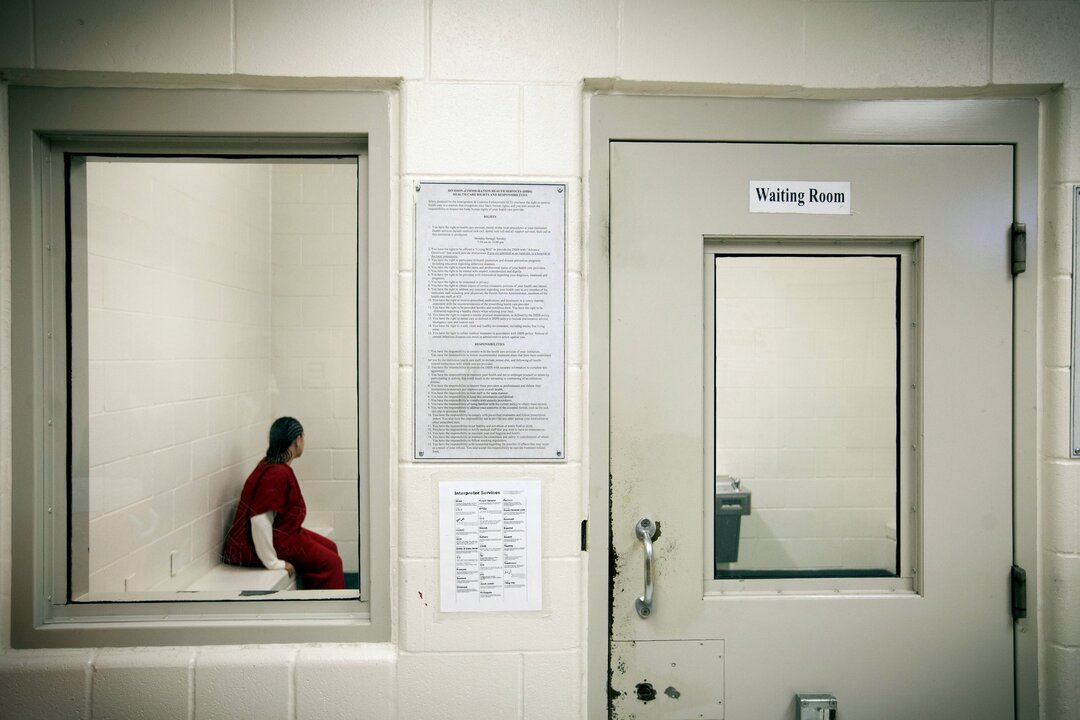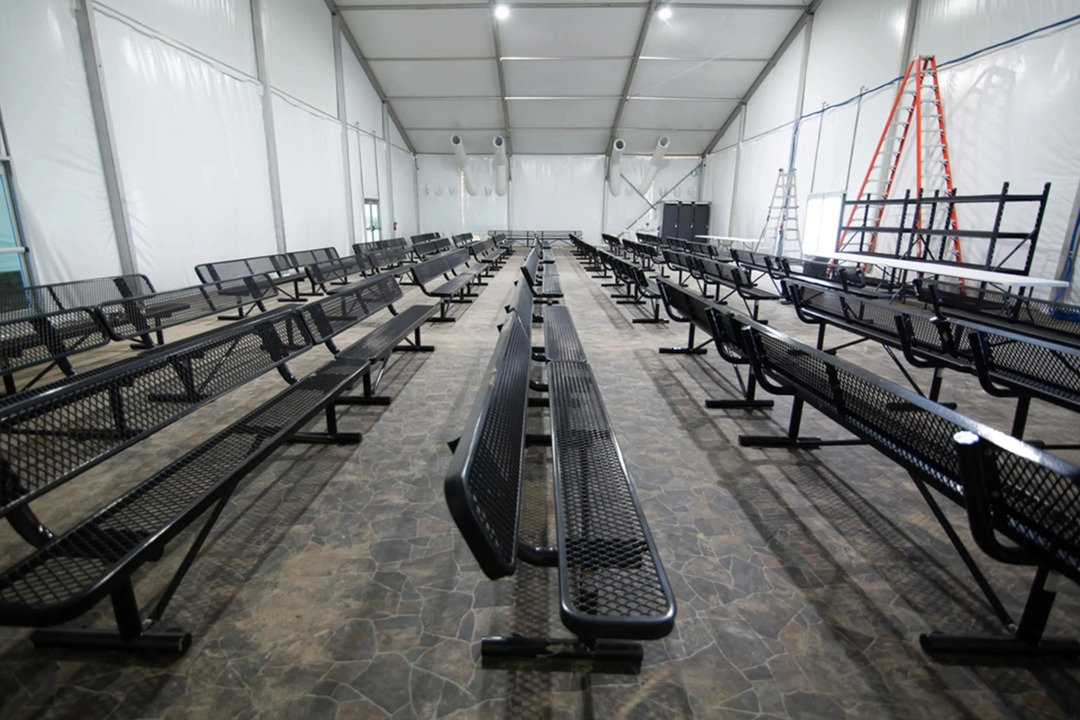Inside America’s Booming Immigration Detention Industry
A Growing Nationwide System
At this very moment, tens of thousands of immigrants are detained in a patchwork of facilities across the United States – the core of a booming immigration detention industry. On January 12, 2025, near the end of President Biden’s term, U.S. Immigration and Customs Enforcement (ICE) held nearly 40,000 people in over 100 detention centers. This marked a steep rise from the pandemic lows of 2020, and the detained population has climbed even higher since. By February 2025, ICE reported over 43,000 detainees in custody – the highest level of detention since 2019. For context, the previous record was about 55,654 detainees in August 2019, at the height of the Trump administration’s first-term crackdown. The United States already operates the world’s largest immigrant detention system, and recent policy shifts suggest it is poised to expand further.
This expansion is nationwide but not evenly distributed. Detention is concentrated in certain regions, especially the South. Nearly 60% of all ICE detainees are held in just 20 megafacilities, predominantly in Texas and the Deep South. For example, the single largest ICE detention center in early 2025 was the Adams County facility in Mississippi (run by CoreCivic), which held over 2,100 people on an average day. Other mammoth centers include the South Texas ICE Processing Center in Pearsall, Texas, and the Stewart Detention Center in Georgia, each holding well over 1,500 detainees. In many of these rural towns, the detention center has become a major employer and a linchpin of the local economy. Some county governments openly treat their ICE contracts “as a business” to generate revenue. In effect, an immigration incarceration archipelago has emerged, stretching from the Texas scrublands to Louisiana bayous and beyond.
Private prison companies dominate this landscape. As of January 2025, a stunning 86% of ICE detainees were held in facilities operated by for-profit contractors. In fact, all of the 20 largest detention centers are managed by private firms – a dramatic privatization of what was once a government-run system. The two giants of the industry, GEO Group and CoreCivic, have become household names in this arena. GEO Group (based in Florida) and CoreCivic (based in Tennessee, formerly Corrections Corp of America) together control dozens of ICE facilities, earning hundreds of millions of dollars per year from ICE contracts. Other companies like LaSalle Corrections (a Louisiana firm) and Management & Training Corporation (MTC) also run sizable centers. ICE still uses some county jails and a handful of federally-run centers, but these are now a minority of beds. Under a Congressional appropriation “bed mandate” in past years, ICE was funded for roughly 34,000 detention beds at any time – a quota that drove up capacity. Although that formal quota was removed in recent budgets, the current push for mass detention far exceeds it.
The profile of detainees has also broadened. Many are asylum seekers or undocumented residents with deep community ties, not dangerous criminals. Internal ICE data show that as of early 2025, over half (52%) of people in ICE detention had no criminal record at all, and many others had only minor offenses like traffic violations. Nonetheless, they are confined in jail-like conditions for civil immigration violations. Average detention times can stretch from weeks to many months, as court backlogs delay cases. Meanwhile, alternatives to detention – such as electronic ankle monitors or community supervision – remain underutilized. Around 185,000 people were in ICE’s Alternatives to Detention (ATD) monitoring programs as of February 2025, a figure that actually fell slightly as the new administration shifted toward more physical detention. The cost differences are stark: holding someone in detention can cost the government hundreds of dollars per day, whereas ATD programs cost on average just $4.42 per day. Despite these cost savings and high compliance rates reported for ATD, recent policy has swung back toward a philosophy of “detain and deport” at all costs.
Recent Developments: Ramping Up for Mass Deportations
In 2025, the U.S. government’s deportation machinery shifted into overdrive. President Donald Trump’s return to the White House for a second term ushered in an aggressive campaign to remove undocumented immigrants on an unprecedented scale. The administration has explicitly set a goal to deport 1 million people per year – far above previous records. Achieving this would require a vast increase in detention capacity and an intense tempo of arrests and deportation flights.
Almost immediately, directives went out to escalate enforcement. In the first week of Trump’s second term (January 2025), ICE headquarters instructed agents to arrest 1,200 to 1,500 people every day. This represented a huge jump from the roughly 1,000 per day rate at the end of the prior administration, and triple the informal targets under President Biden. By late February 2025, ICE’s detention centers were reported at 109% capacity – effectively overfilled – due to the surge in arrests. Internal plans were quickly announced to triple ICE’s detention capacity, adding space for an additional 84,000 detainees. If realized, this expansion would push the total capacity well into six figures, a scale previously unimaginable.
To find room for so many people, the administration has been scrambling for beds. ICE has leaned on local and state partners, reviving agreements with county jails and soliciting new contracts. The president’s newly appointed “border czar,” Tom Homan, even suggested lowering federal detention standards to entice more county sheriffs to participate – effectively cutting corners on conditions in order to pack in more detainees. The administration also turned to more extreme solutions: in a move with few modern precedents, President Trump signed an executive order in January 2025 authorizing the use of the Guantánamo Bay naval base to detain up to 30,000 immigrants. By taking over part of the notorious offshore prison – a facility designed for enemy combatants – officials aimed to bypass domestic constraints. Guantánamo is remote, making legal access difficult, and is staffed by military personnel accustomed to guarding war prisoners. Notably, a private contractor named Akima was hired to run the migrant holding operations at Guantánamo; that company has a documented history of abuse and civil rights complaints. Reports from the base indicate migrants have faced intimidation and mistreatment, from strip searches to solitary confinement, prompting hunger strikes and suicide attempts.
Back on the mainland, the administration is eyeing other military bases for detention camps. Plans are underway to build a large “deportation hub” at Fort Bliss in Texas to hold up to 10,000 people. The growing involvement of the Department of Defense in immigration enforcement has alarmed observers, since soldiers are not trained in civil detention and such facilities may escape regular oversight. At a July 2025 press event, Trump stood alongside Florida’s governor at a disused airfield in the Everglades – a site slated to become a sprawling detention center infamously nicknamed “Alligator Alcatraz.” “Very soon this facility will have some of the most menacing migrants, some of the most vicious people on the planet,” Trump proclaimed of the planned camp. It later emerged that two construction firms awarded contracts for “Alligator Alcatraz” were major political donors to Trump and Governor DeSantis, raising questions about patronage in the rush to expand detention.
The administration has also moved to widen the net of who can be detained. Early on, it reversed previous limits and announced a return to family detention – holding migrant parents and children together in custody. Family detention centers had been introduced under Obama (and were the site of intense controversy) but were largely discontinued under President Biden in favor of alternatives. Now Trump officials are reactivating these facilities, contending that entire families should be held until deported. In practice, this often means detaining mothers and young children (fathers are typically separated due to space or policy) – which critics note is just another form of family separation. Medical experts and human rights groups have long warned that even short-term detention can inflict lasting trauma on children, who may suffer developmental regression, anxiety, and depression. U.S. law, under the Flores court agreement, limits the detention of children to 20 days, but authorities have explored work-arounds to keep families locked up for longer.
To meet its arrest quotas, ICE has dramatically intensified operations across the country. Gone is the previous policy (under Biden) of prioritizing serious criminals or recent border crossers. Everyone without legal status is now fair game. Reuters reporting revealed that ICE has been given a daily arrest target of 3,000 people – triple the prior goal of 1,000 per dayr. To hit these numbers, agents have adopted sweeping tactics. They are canvassing workplaces and public spaces, picking up day laborers outside hardware stores and restaurants, and even detaining a high school student after a traffic stop. Courthouse arrests – grabbing immigrants who show up for unrelated court matters – have also spiked. “It seems like they’re just arresting people they think might be in the country without status... It’s all about the numbers, not the level of criminality,” observed Julia Gelatt of the Migration Policy Institute, noting that these indiscriminate sweeps undercut claims of focusing on “the worst of the worst”. ICE’s new marching orders reportedly came after White House advisor Stephen Miller excoriated agency leadership for “insufficient arrests” – demanding they abandon targeted operations and “pick up any immigration offenders” to boost the totals. According to multiple officials, Miller explicitly told ICE to target locations like Home Depot and 7-Eleven stores where migrant workers gather. The clear message: maximize deportations by any means necessary.
Administration officials argue these hardline measures fulfill a mandate from voters. They point to Trump’s campaign promise of mass deportations and claim a popular mandate to “restore law and order” in immigration. The White House has defended the push as necessary to deter illegal migration and protect jobs for Americans. But the escalation has provoked public outrage and protests in some communities. In Los Angeles, for example, demonstrators poured into the streets after ICE raids swept up workers at local Home Depots, garment factories, and warehouses. Immigrant-rights advocates and many Democrats condemn the tactics as cruel and counterproductive, warning that they instill terror in immigrant communities. Even some legal residents and visitors have been caught up in the dragnet, creating a climate of fear. One organizer quipped that ICE’s new fantasy of becoming “Amazon Prime for deportations” – delivering human beings as efficiently as packages – reveals an alarming corporate mentality behind the mass deportation agenda. The Border Security Expo held in Phoenix in April 2025 underscored this mentality. There, Acting ICE Director Todd Lyons bluntly stated, “We need to get better at treating this like a business… like [Amazon] Prime, but with human beings”. Lyons, along with Trump’s “border czar” Homan and DHS Secretary Kristi Noem, emphasized that the administration is leaning heavily on the private sector – from tech companies to defense contractors – to carry out its mass deportation plans. “Let the badge and guns do the badge-and-gun stuff. Everything else, let’s contract out,” Homan declared at the expo, a nod to the many corporate representatives in attendance. Indeed, ICE has courted tech firms for tools like artificial intelligence to help “free up bed space” and “fill up airplanes” with deportees faster. Even airlines have joined in: budget carrier Avelo Airlines signed a deal to run deportation flights from Arizona, prompting public petitions against it. The deportation drive is not just a government campaign – it’s becoming a booming business enterprise.
Big Business: Profits for Private Detention Companies
Behind the scenes of this deportation surge are corporations seeing record profits and opportunities for growth. The Trump administration’s tough policies have been a financial windfall for the private prison industry that runs most immigration detention centers. Executives at the two largest companies – GEO Group and CoreCivic – have been positively giddy in recent investor calls. “I’ve worked at CoreCivic for 32 years, and this is truly one of the most exciting periods of my career,” said CoreCivic CEO Damon Hininger during a February 2025 earnings call. “We anticipate significant growth opportunities, perhaps the most significant growth in our company’s history over the next several years”. GEO Group’s CEO, Brian Evans, likewise told investors that his firm could reap an additional $400 million in annual revenue by filling currently empty beds if the new administration fully carries out its plans. The stock market has noticed: GEO Group’s stock price jumped over 80%in the wake of Trump’s 2024 election victory, and CoreCivic’s shares also surged by double digits. Few industries stand to gain as directly from the government’s policies as these detention contractors.
Political ties and lobbying have greased the wheels of this profitable system. Private prison companies were early supporters of Trump’s return to office. GEO Group funneled at least $1 million to a pro-Trump Super PAC ahead of the 2024 election, using a subsidiary to sidestep rules against federal contractors donating to campaigns. CoreCivic’s political action committee and executives likewise heavily favor Republicans – CoreCivic’s president Damon Hininger personally gave $300,000 to Trump’s joint fundraising committee in 2024. This investment appears to be paying off. “Trump’s first time in office was a free-for-all for companies giving money to his campaign… We’re going to see that on overdrive during his second term,” commented Robert Maguire of the watchdog group CREW, noting how private prison companies are positioning themselves to benefit. In the last Trump administration (2017-2021), ICE opened 40 new detention facilities, and GEO Group’s annual revenue rose from $2.17 billion to $2.35 billion. Both GEO and CoreCivic saw their government contracts balloon as harsher immigration enforcement took hold. Little wonder these firms have cheered the latest push: GEO’s founder George Zoley openly stated that the private sector will be “critical” in helping the government achieve its mass deportation objectives.
How exactly do these companies make money? Primarily through per-diem contracts: ICE pays a set rate per detainee per day. Many contracts include guaranteed minimum payments – for example, CoreCivic’s deal for the Torrance County Detention Facility in New Mexico guarantees payment for 724 beds per day whether filled or not. This means even if ICE doesn’t use those beds, the company still profits. In effect, the government often pays for empty “ghost” beds, a practice watchdogs have criticized as wasteful. When detainee numbers surge, however, those beds are quickly filled and profits grow. Companies also charge for various services. They sometimes operate their own transportation fleets for moving detainees (or, like GEO, run charter deportation flights). GEO Group has even expanded into “alternatives to detention” by offering to supply ankle monitors and electronic check-in systems – essentially monetizing every aspect of the custody continuum. As one GEO executive boasted, they assured ICE of the ability to “rapidly scale up” and monitor “several hundreds of thousands, or even several millions” of people through tech solutions as needed.
Another lucrative angle is labor within detention centers. Facilities often rely on detainees to perform cooking, cleaning, and maintenance work, typically paying them a token $1 per day or even less. Both GEO Group and CoreCivic have been hit with lawsuits alleging these “volunteer” work programs violate labor laws and unjustly enrich the companies. Detainees who refuse to work have reported being punished with solitary confinement. While the companies deny wrongdoing – arguing that the work is voluntary and a longstanding practice – internal documents show GEO at one point sought federal reimbursement for legal costs after being sued over forced labor. Despite such controversies, the detention business model remains intact: minimize operating costs (often by skimping on staffing or services) and maximize occupancy. The incentives are clear, and critics say this profit motive is fundamentally at odds with detainee welfare. As one analysis by The Marshall Project noted, for-profit operators are driven to cut costs on care to boost margins, a dynamic that can lead directly to neglect and abuse. Private prisons have a documented pattern of understaffing and safety issues – problems so severe that the U.S. Department of Justice decided in 2016 to phase out private prisons for federal inmates (a decision later reversed). Yet when it comes to immigration detention, these same companies continue to enjoy booming business.
Not only companies profit – local governments do as well. Many county jails that contract with ICE view detainee housing as a revenue generator. In California, for instance, ICE paid one county $55 million in a single year to rent jail space. Officials in those jurisdictions have sometimes become de facto partners in the detention enterprise. (Emails obtained by journalists have even shown sheriffs lobbying ICE to send more detainees when their jail populations – and thus budgets – dipped.) This intertwining of financial incentives with immigration enforcement troubles human rights advocates. They point out that small towns can become dependent on federal detainee dollars, creating pressure to support tougher immigration policies to keep the jails full. It also means that any push to close a problematic detention facility can face local political resistance because of jobs and money at stake.
Meanwhile, revolving doors and insider influence abound. Private detention companies frequently hire former ICE and DHS officials into high-paying executive roles, leveraging their connections. For example, GEO Group hired a recently retired ICE detention chief as a consultant, one of many such moves over the years. Emails released via FOIA have shown GEO and CoreCivic representatives regularly communicate with ICE officials about contract terms and upcoming needs. These companies also spend generously on lobbying in Washington. In theory, government contracts are arms-length and driven by need and cost; in reality, critics say, the industry’s political clout has helped shape policy. They note that in 2017, DHS memos set a goal of 85,000 immigrants detained per day – a number that conveniently matched what private contractors were eager to supply. “We believe that the private sector will play a critical role in assisting the government in carrying out its objectives,” GEO’s CEO Zoley said plainly. The line between public policy and private profit has grown perilously thin.
Complaints of Abuse and Neglect
While companies and officials tout the efficiency of this expanding system, detainees tell a different story – one of overcrowding, squalid conditions, and routine abuse. From inside the locked facilities, immigrants have raised alarm about what they call inhumane treatment. “They treat us like we’re animals,” said a frustrated detainee held at the Torrance County Detention Facility in New Mexico. That facility, run by CoreCivic, became notorious after a 2022 federal watchdog report found “shockingly unsanitary” conditions and severe understaffing, so dire that the DHS Inspector General urged ICE to remove all detainees immediately. Photos showed cells flooded with sewage from broken pipes, mold-infested walls, and inoperative bathrooms. Yet ICE did not shut Torrance down. According to detainees interviewed by the ACLU, even basic medical care there was almost impossible to obtain – nine out of 34 healthcare positions were vacant at one point, including no doctor on site for months. Torrance became a symbol of everything that can go wrong in a for-profit detention center: it failed its annual inspections, ignored repeated warnings to improve, and even allegedly covered up problems. In 2020, during a COVID-19 outbreak, a group of detainees staged a peaceful hunger strike over the conditions; CoreCivic’s response was to use pepper-spray on the protesting migrants while they were trapped inside, an incident later documented in legal filings.
Sadly, such stories are not isolated. Independent investigations and lawsuits have uncovered patterns of neglect and abuse in ICE facilities nationwide. Common complaints include: grossly inadequate medical care, unsanitary living quarters, overuse of solitary confinement, barriers to legal access, and physical or sexual abuse by guards. A joint report by the ACLU, Physicians for Human Rights, and American Oversight reviewed medical records in dozens of detention deaths and delivered a damning conclusion: 95% of deaths in ICE custody from 2017-2021 were preventable or potentially preventable with basic medical attention. In other words, virtually all of those deaths – 52 people over five years – might have been avoided had detention centers provided timely and adequate care. Instead, detainees often face long delays to see doctors, language barriers in describing symptoms, and instances of negligence or indifference by staff. The cases range from diabetics not receiving insulin, to cancers going undiagnosed, to suicide risks being ignored. At an ICE prison unit inside the federal Leavenworth penitentiary, detainees reported being locked down in their cells for 72 hours at a stretch due to staff shortages, with only sporadic access to showers or fresh air. At another facility in Miami, immigrants say they have been effectively denied communication with the outside world – legal documents and mail withheld, phones so limited that contacting attorneys or family is nearly impossible. These issues prompted a coalition of civil rights groups in May 2025 to demand an end to ICE’s use of certain federal prisons, calling the conditions “inhumane and illegal” and arguing that detaining people while blocking access to counsel violates fundamental constitutional rights.
In facility after facility, harrowing anecdotes have emerged. In Louisiana’s Winn Correctional Center (another large ICE site run by LaSalle), guards were accused in 2019 of retaliating against peaceful protesters by beating and pepper-spraying them. In New Jersey’s Essex County jail, an investigation found detainees had been served foul, spoiled food and kept in dirty, vermin-infested units. And at Georgia’s Irwin County Detention Center, a chilling scandal broke in 2020: a whistleblower nurse, Dawn Wooten, alleged that an outside gynecologist contracted by the private operator was performing an alarming number of unnecessary hysterectomies on female detainees without proper consent. “Everybody he sees has a hysterectomy – just about everybody,” Wooten said of the doctor. “That’s his specialty, he’s the uterus collector. Everybody’s uterus cannot be that bad”. One detained woman, upon learning how many others had been subjected to surgery, told investigators, “I thought this was like an experimental concentration camp”. The reports sparked national outrage and multiple inquiries. (Federal officials later confirmed that numerous women underwent gynecological procedures there, and the center’s ICE contract was ultimately terminated.) The Irwin case highlighted the powerlessness of detainees: immigrants who did speak up, Wooten said, were promptly thrown into solitary confinement as punishment. Fear of retaliation keeps many abuses hidden. Yet over the years, hundreds of grievances have still managed to surface. According to a recent investigative report, at least 308 complaints of sexual assault or abuse were filed by ICE detainees between 2015 and 2021 – more than half alleging misconduct by facility staff. These include strip searches that devolved into assault, guards trading favors for sex, and incidents of harassment of LGBTQ detainees. Advocates warn that because immigration detention has murkier oversight than prisons, such abuses often go unpunished.
Even basic necessities can be a struggle behind barbed wire. Detainees frequently report foul water, inadequate food, lack of hygiene supplies, and frigid temperatures. (Overcrowded border holding cells nicknamed “hieleras” or iceboxes for their cold have been widely reported in the past.) Many ICE facilities have no outdoor recreation; some have lights on 24 hours a day. Mental health care is minimal, even as detainees endure extreme stress and uncertainty about their fates. It’s no surprise that desperation mounts. Hunger strikes have erupted at numerous centers as a form of protest, with detainees refusing meals to demand better conditions or release. ICE’s response has often been to seek court orders to force-feed hunger strikers through tubes – a practice condemned by the United Nations when used on immigrant detainees. Tragically, death in custody remains a recurring headline: from 2017 through 2020 alone, at least 21 people died in ICE detention, including from treatable illnesses like pneumonia and from suicide after prolonged isolation. In one notorious case, a 33-year-old asylum seeker from Cuba died of a brain hemorrhage in 2019 after allegedly receiving substandard care for weeks. In another, a young man from Honduras killed himself after spending over a year in solitary confinement despite known mental health issues.
For detainees, these facilities can feel like prisons with no end date. Unlike criminal sentences, immigration detention is indefinite – many don’t know if they’ll be held for weeks, months, or even years. They are civil detainees not serving time for a crime, yet they often endure conditions worse than those of convicted felons. As one immigration attorney put it, “Detaining someone and undermining their due process by blocking access to counsel is... indefensible,” especially when those detained “are not accused of any crime”. This collision of a profit-driven detention model with vulnerable individuals has led the U.N. and human rights groups to condemn U.S. immigration detention practices as violative of basic human rights. The detainees’ own words perhaps illustrate it best: “The living situation is disgusting – the sinks are stopped up, the showers are disgusting, the water we drink is disgusting as well,” said a man held at Torrance, before reiterating, “They treat us like we’re animals.” Such testimonies fuel the growing debate over how – or if – the U.S. can reconcile the business of detention with respect for human dignity.
Policy Debates and the Road Ahead
The explosive growth of immigration detention in America has sparked intense policy debates about its necessity, oversight, and morality. On one side, proponents argue that robust detention is an essential tool for enforcing immigration law. They claim that the threat of detention and swift deportation deters unauthorized migration and ensures that those here unlawfully do not abscond before removal. Trump administration officials often assert that alternatives like monitoring are insufficient and that “we need detention assets” to meet enforcement goals. Even some Democrats acknowledge that a certain amount of detention capacity is needed, for example to hold those with violent criminal histories or to process recent border arrivals in an orderly way.
On the other side, a broad coalition of immigrant-rights advocates, civil liberties groups, and some lawmakers are pushing to rein in or radically reform the detention system. They point out that the U.S. managed immigration for most of its history without mass detention – large-scale immigrant jailing is a relatively recent phenomenon of the last few decades. Critics contend that detention is overused, costly, and often legally unjustified. Many asylum seekers and long-time residents pose no flight risk or danger, they argue, and could be released on bond or supervised parole while their cases proceed. Notably, during the COVID-19 pandemic, ICE was forced to drastically decrease the detained population for health reasons, and there was no resulting chaos; most released migrants appeared for their court dates. This has strengthened advocates’ calls to expand community-based alternatives permanently and reserve detention for truly high-risk individuals.
A key flashpoint is the role of private for-profit prisons in civil immigration detention. Opponents of privatization say that profiting from confinement creates perverse incentives. When corporate executives talk of “growth opportunities” in detaining human beings, it raises moral questions. In 2021, President Biden acknowledged some of these concerns by signing an executive order to end the Justice Department’s use of private prisons – but crucially, that order did not cover ICE facilities. ICE, under the Department of Homeland Security, was exempt, and private companies continued to operate the majority of ICE centers. President Biden did campaign on a promise to reduce or eliminate private immigration detention, and during his term a handful of notorious centers were closed (for instance, an ICE family detention center in Berks County, Pennsylvania was shut after years of protest). However, other closures were blocked or offset. In one case, the Biden administration even sided with CoreCivic in a lawsuit to keep open a detention facility in New Jersey, which local authorities wanted to shut down; the facility not only remained open but later doubled its population. This mixed record reflects the political complexity: any significant drawdown of detention meets fierce resistance from those arguing it would compromise immigration enforcement.
Some states have tried to act on their own. California, for example, passed a law (AB32 in 2019) to ban private immigrant detention centers in the state. That law has faced legal challenges – the Trump administration joined private prison companies in suing to overturn it, claiming federal operations can’t be constrained by state law. (As of 2025, the litigation is still unfolding, with higher courts weighing the balance between states’ rights and federal immigration powers.) Other states like Illinois and New Jersey have successfully terminated ICE contracts at local jails, forcing ICE to transfer detainees elsewhere. These efforts form part of a broader progressive call to “abolish ICE” or at least drastically shrink its detention capacity, arguing that the agency’s enforcement approach has become too punitive and harmful.
Ensuring basic standards and oversight is another area of debate. ICE maintains that it has strict detention standards – the agency points to its 2011 Performance-Based National Detention Standards and subsequent updates meant to guarantee health, safety, and due process. In practice, though, enforcement of these standards is inconsistent. ICE relies on a private inspector (the Nakamoto Group) to audit facilities, but Nakamoto has been widely criticized as “notoriously lax”. Whistleblowers have described inspections that are perfunctory, with advance notice given to wardens and detainees often afraid to speak freely. Even when serious deficiencies are identified, ICE’s response has been questioned. For instance, after repeated failures at Torrance, ICE fined CoreCivic only a modest amount and continued the contract. Under the Trump administration, internal watchdogs have been sidelined: in 2025, the administration moved to dismantle the Office of the Immigration Detention Ombudsman, a relatively new office that had been tasked with investigating abuse in facilities. They also curtailed the DHS Office for Civil Rights and Civil Liberties, which traditionally helped oversee detention conditions. These moves alarmed advocacy groups and some members of Congress, who see them as removing critical checks just when detention is expanding most. American Oversight and other NGOs have filed Freedom of Information Act requests and lawsuits to uncover what is happening behind closed doors, from Guantánamo plans to ICE’s confidential agreements with local authorities.
In Congress, legislative proposals have been introduced (and re-introduced) to reform immigration detention. Bills like the Dignity for Detained Immigrants Act seek to set higher standards (such as minimum medical care requirements, limits on solitary confinement, and greater access to attorneys) and to phase out private contracts over time. Other bills have aimed at specific issues – for example, capping the exorbitant phone rates detainees must pay to call family, or ending the so-called “bed quota” that pressured ICE to detain a certain number of people daily. So far, these efforts have not mustered the bipartisan support needed to become law. The political winds have shifted in the opposite direction with the current administration’s tough stance. Still, public opinion polls show Americans are divided, with a significant share expressing concern about the humanitarian treatment of immigrants. Revelations like the Georgia involuntary hysterectomies or the high death rates in custody have fueled calls for an independent investigation into ICE facilities. Some lawmakers have urged a halt on expanding detention until conditions improve. “We must not fund the abuse of immigrants with taxpayer dollars,” one congresswoman declared, referencing reports of migrants who fell ill or died after poor care.
The debate extends to the fundamental purpose of immigration detention. Is it meant to ensure compliance with deportation orders, or is it being used as a de facto punishment for immigration violations? The U.S. Supreme Court has upheld the government’s authority to detain non-citizens during removal proceedings, but it also warned that detention is not supposed to be punitive. Human rights law experts note that many peer nations use detention far more sparingly – for example, Canada detains a tiny fraction of asylum seekers compared to the U.S., relying on community supervision instead. The U.N. has called on countries to end the detention of children outright, a standard the U.S. has repeatedly been urged to meet. With the revival of family detention, that controversy is back in full force. In early 2025, Democratic lawmakers re-introduced a bill to ban family detention and set minimum standards for any facility holding minors, citing the psychological harm and moral cost of jailing kids even for short periods.
Looking ahead, America’s immigration detention industry stands at a crossroads. On its current trajectory, it is growing into a vast network entwined with the country’s law enforcement and corporate interests – “a machine for mass deportations” powered by taxpayer money and private profit. If the administration’s plans proceed, tens of thousands more migrants will be behind bars, generating billions in revenue for contractors but also likely generating a trail of trauma and rights violations. This has prompted a backlash from civil society. Coalitions of legal and religious groups have launched campaigns to “Defund Hate”, urging Congress to cut ICE’s detention budget and invest in community case management programs instead. They argue that a humane immigration system would treat people not as inventory to be processed or “commodities” to be warehoused for profit, but as human beings deserving of dignity and fair process.
Yet with the politics of immigration still polarized, meaningful reforms face an uphill battle. For now, the detained keep calling out from behind the walls. “Denying detained immigrants access to legal documents, mail, and phone calls makes it all but impossible to fight and win an immigration case,” noted Sui Chung, director of Americans for Immigrant Justice, about conditions in a Miami facility. Due process, a cornerstone of the American legal system, is at stake when immigrants cannot contact lawyers or gather evidence. The treatment of detainees has even begun to affect international perceptions: travel data suggest that fear of ICE actions has led to a marked drop in foreign visitors coming to the U.S., an unexpected economic side effect.
